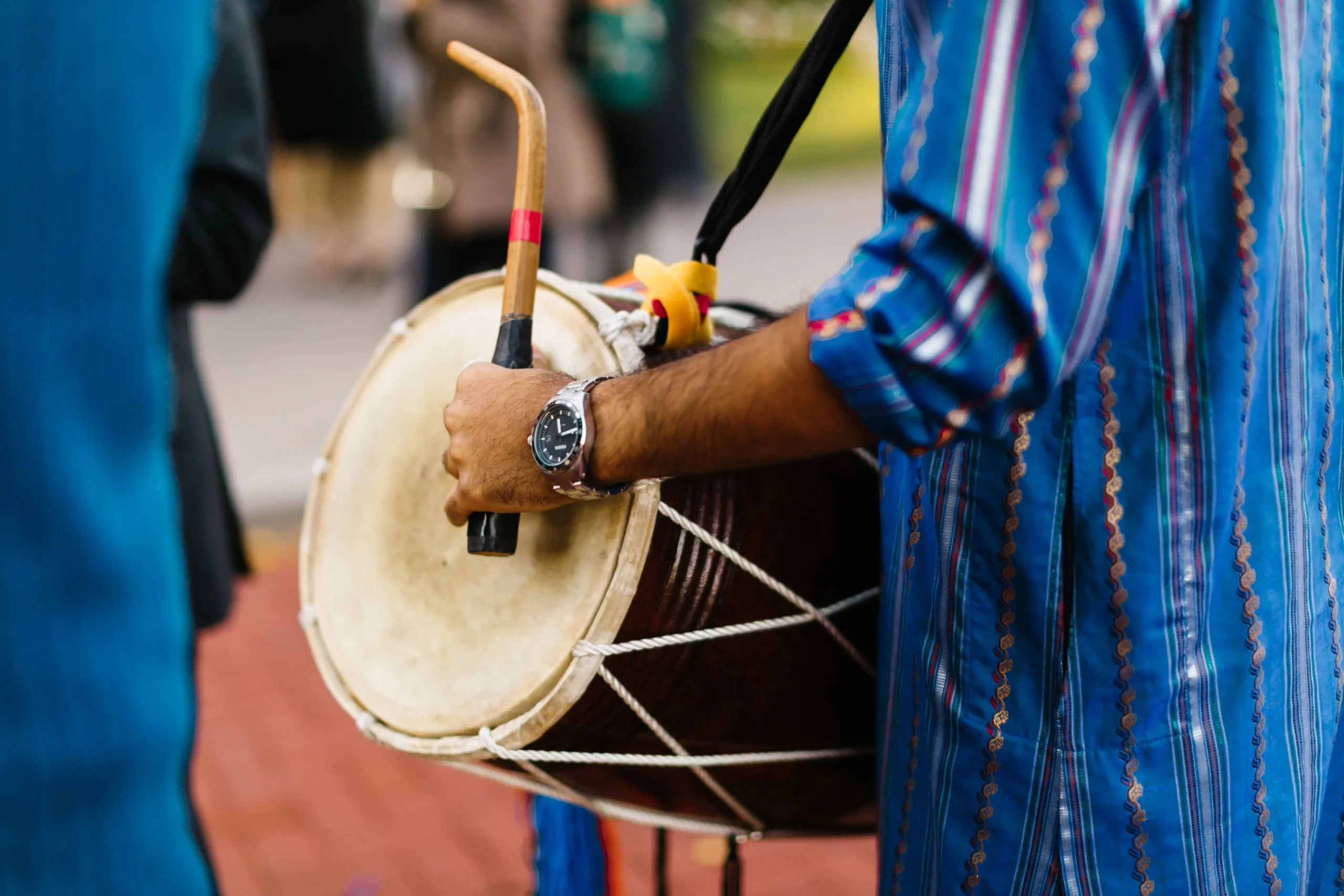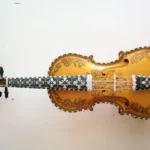
The Dhol, a traditional drum originating from North India and Pakistan, embodies the rhythmic heartbeat of South Asian musical heritage. With roots dating back to the 14th century during the Delhi Sultanate rule, this iconic instrument has evolved into a symbol of cultural pride and celebration. From its traditional construction and playing techniques to its widespread cultural significance and global recognition, the Dhol encapsulates the rich tapestry of musical traditions that resonate across diverse communities and generations. In this exploration, we delve into the multifaceted world of the Dhol, uncovering its history, craftsmanship, cultural significance, and enduring legacy in the ever-changing landscape of global music.
Origin during Delhi Sultanate Rule: The Dhol, a traditional drum originating from North India and Pakistan, has roots tracing back to the 14th century during the Delhi Sultanate rule. Its evolution was influenced by various cultural and historical factors prevalent in the region at the time. As an integral part of local music and festivities, the Dhol’s inception likely occurred as a fusion of indigenous percussion instruments with those introduced by Central Asian invaders. Over centuries, it has become synonymous with the vibrant cultural landscape of the Indian subcontinent, serving as a symbol of regional identity and pride.
Etymology and Meaning: The term “Dhol” derives from Hindustani languages, specifically Hindi and Urdu, where it simply translates to “drum.” This straightforward nomenclature reflects the instrument’s primary function as a percussive device. Despite its simplicity, the Dhol embodies a rich tapestry of cultural significance, embodying the rhythmic heartbeat of various musical genres and social gatherings across South Asia and beyond.
Traditional Construction Materials: Originally crafted from seasoned wood like mango or shisham, the Dhol’s shells represented a harmonious blend of craftsmanship and natural materials. This traditional approach not only imparted a distinct resonance to the instrument’s sound but also symbolized a connection to the earth and cultural heritage. However, modern innovations have seen the incorporation of lighter materials such as fiberglass, offering practical advantages in terms of portability and durability while still preserving the essence of the Dhol’s sonic character.
Standard Dimensions: The Dhol typically adheres to standard dimensions, with a width ranging from 40 to 45 centimeters and a height spanning 60 to 65 centimeters. These proportions, honed over centuries of tradition, strike an optimal balance between ergonomics and acoustics, ensuring comfortable playability for musicians while maximizing the instrument’s sonic projection. Such standardized dimensions also facilitate the interchangeability of components and the replication of traditional designs across diverse cultural contexts.
Drumhead Construction and Tensioning System: The Dhol’s distinctive sound is primarily attributed to its dual drumheads, typically fashioned from goat or buffalo skin for their resilience and tonal richness. These skins are meticulously secured to the shell using a tensioning system comprised of rope or leather straps. This arrangement allows for precise tuning adjustments, enabling Dhol players to achieve a desired balance between pitch, resonance, and responsiveness. Such meticulous craftsmanship underscores the instrument’s artisanal heritage and the importance of skilled luthiers in its production.
Playing Techniques and Implements: Dhol players, known as Dholis, employ a variety of techniques and implements to elicit an array of rhythmic textures from the instrument. The larger drumhead, known as the “dagga,” is struck with a curved stick called a “dholki,” while the smaller drumhead, known as the “thili,” is addressed with a straight stick known as a “tihli.” These implements, carefully chosen for their size, weight, and material composition, enable Dholis to navigate the instrument’s dynamic range with precision and expressiveness, weaving intricate rhythms that animate listeners and dancers alike.
Role in Punjabi Folk Music and Bhangra: Within the realm of Punjabi folk music, the Dhol occupies a central position, its thunderous beats driving the infectious energy of Bhangra performances. With a tempo typically hovering around 140 to 150 beats per minute, Bhangra music pulses with a joyous vitality that reflects the exuberance of rural life and communal celebrations. The Dhol’s commanding presence in this genre underscores its ability to transcend cultural boundaries and evoke a shared sense of euphoria among participants and spectators alike.
Guinness World Records: The Dhol’s enduring popularity has manifested in various Guinness World Records, showcasing the instrument’s global appeal and cultural resonance. The feat of assembling a massive Dhol ensemble exemplifies this. In April 2023, the State of Assam, India, set a record with 2,651 Dhol players, highlighting the instrument’s capacity to foster community cohesion and collective achievement on a grand scale.
Commercial Availability and Size: While traditional Dhol designs adhere to standard dimensions, contemporary iterations have expanded in size and scope to accommodate diverse musical preferences and performance contexts. Commercially available Dhols may exceed traditional specifications, with dimensions reaching approximately 55 centimeters in width and 75 centimeters in height. This expanded form factor not only enhances the instrument’s visual presence but also augments its sonic footprint, yielding deeper bass tones and heightened projection suitable for modern amplification and recording techniques.
Role in Sufi Music: Beyond its association with secular festivities, the Dhol occupies a revered position in Sufi music, a spiritual tradition characterized by its mystical poetry and devotional fervor. Within this context, the Dhol serves as a conduit for transcendence, its pulsating rhythms and thunderous resonance elevating listeners to a state of ecstatic communion with the divine. Sufi Dhol playing often encompasses intricate rhythmic patterns and improvisational flourishes, reflecting the improvisatory spirit and emotional intensity inherent to the mystical experience. As such, the Dhol’s presence in Sufi gatherings epitomizes its capacity to transcend cultural boundaries and facilitate profound spiritual encounters.
Traditional Attire and Performance: Dhol players adorn themselves in vibrant, traditional attire during performances, amplifying the visual spectacle and cultural resonance of their music. Vibrantly colored clothing and intricately adorned turbans symbolize festivity and cultural pride, enhancing the overall ambiance of celebratory occasions. These sartorial choices not only reflect regional aesthetics but also serve as a visual manifestation of the rhythmic energy and communal spirit embodied by the Dhol’s music.
International Recognition: The Dhol has garnered widespread international recognition in recent decades, propelled by the global dissemination of Bhangra music and the influence of Bollywood films. Its infectious rhythms and dynamic timbres have captivated audiences worldwide, transcending linguistic and cultural barriers to become emblematic of South Asian musical identity. As a result, the Dhol has found resonance in diverse musical contexts, from electronic dance music (EDM) to hip-hop, where its distinctive beats infuse tracks with an unmistakable sense of vitality and exuberance.
Cultural Significance: The Dhol occupies a central role in numerous South Asian cultural events, ranging from weddings and religious festivals to national holidays and community gatherings. Its presence serves as a unifying force, fostering a sense of collective identity and shared heritage among participants. Whether heralding the joyous union of newlyweds or accompanying fervent devotional chants during religious processions, the Dhol’s rhythmic pulse infuses these occasions with a palpable sense of joy, unity, and celebration.
Sense of Unity and Merriment: The rhythmic energy of the Dhol is believed to engender a profound sense of unity and merriment among participants and spectators alike. Its pulsating beats serve as a communal rallying cry, drawing individuals together in shared expression and collective jubilation. Whether amidst the swirling throngs of a crowded dance floor or the reverent hush of a religious ceremony, the Dhol’s resounding cadences evoke a sense of connection and camaraderie that transcends social divides and cultural differences.
Physical Demands of Playing: Learning to play the Dhol requires a combination of coordination, physical strength, and mental acuity. As Dholis wield their implements with precision and power, they must exert considerable force to elicit the instrument’s resonant tones. Mastery of technique entails rigorous practice and disciplined training, honing both muscle memory and auditory perception to navigate the instrument’s intricate rhythmic patterns with fluency and finesse.
Tonal Variations and Rhythmic Patterns: Skilled Dhol players possess the ability to produce a wide range of tonal variations and complex rhythmic patterns, showcasing their virtuosity and musical sensitivity. Through subtle adjustments in striking technique, tensioning of drumheads, and manipulation of dynamics, they imbue each performance with nuance and expression, eliciting a kaleidoscope of sonic textures and emotional resonances. From thunderous bass strokes to delicate high-pitched accents, the Dhol’s sonic palette is as diverse as the musical traditions it accompanies.
Affordability and Accessibility: Despite its storied heritage and artisanal craftsmanship, the Dhol remains a relatively affordable instrument, making it accessible to musicians of all backgrounds. Its widespread availability ensures that aspiring players can procure instruments with ease, fostering inclusivity and democratizing access to traditional musical practices. This accessibility not only sustains the instrument’s cultural relevance but also cultivates a vibrant community of enthusiasts and practitioners who contribute to its ongoing evolution and innovation.
Artisanal Craftsmanship: The Dhol is a handcrafted instrument, with each instrument bearing the mark of its maker’s skill and expertise. The craft of Dhol making is passed down through generations within certain families, preserving traditional techniques and aesthetic sensibilities. From the selection of premium materials to the painstaking assembly and finishing processes, Dhol makers exhibit a profound commitment to quality and craftsmanship, ensuring that each instrument meets exacting standards of excellence.
Impact of Shell Thickness and Wood Type: The sonic characteristics of the Dhol are influenced by factors such as shell thickness and wood type, which contribute to its overall tonal quality and resonance. Thicker shells tend to produce deeper, more resonant tones, while thinner shells yield brighter, more articulate sounds. Likewise, different wood types impart distinct sonic signatures, with dense hardwoods like shisham offering rich, warm tones and lighter woods like mango providing crisp, responsive articulation. Such nuances underscore the instrument’s versatility and adaptability to diverse musical contexts.
Tuning and Amplification: Dhol players often fine-tune their instruments by adjusting the tension of the head straps, allowing for precise control over pitch and resonance. This meticulous tuning process enables Dholis to tailor the instrument’s sound to suit specific musical settings and performance requirements, ensuring optimal clarity and projection. In modern contexts, electronic amplification may be employed to enhance the volume and presence of the Dhol in large venues or amplified ensembles, expanding its sonic reach and versatility in contemporary musical settings.
Continued Evolution and Innovation: Despite its ancient origins, the Dhol continues to evolve and find new applications in contemporary music scenes worldwide. From traditional folk ensembles to cutting-edge fusion projects, its adaptability and versatility have ensured its enduring relevance in the ever-changing landscape of global music. As artists and musicians continue to explore new sonic territories and creative possibilities, the Dhol remains a dynamic and vital force, bridging past and present, tradition and innovation, with its resounding beats and timeless appeal.
Iconic Status and Cultural Symbolism: As one of the most recognizable symbols of South Asian musical heritage, the Dhol occupies an iconic status that transcends geographical boundaries and cultural divides. Its rhythmic pulse resonates with a sense of cultural pride and identity, serving as a potent emblem of shared heritage and collective memory for millions of people around the world. Whether on the bustling streets of Mumbai or the dance floors of London, the Dhol’s unmistakable timbres evoke a sense of belonging and celebration that transcends linguistic and cultural barriers.
Cross-Cultural Influence and Fusion: The Dhol’s rhythmic vitality and infectious energy have permeated diverse musical genres and cultural contexts, sparking a wave of cross-cultural fusion and innovation. From collaborations with Western pop artists to experimental electronic projects, its pulsating beats and dynamic grooves have left an indelible mark on the global music landscape. By embracing diverse influences and forging new creative pathways, the Dhol continues to inspire artists and audiences alike, uniting disparate traditions in a vibrant tapestry of sonic exploration and cultural exchange.
Educational and Community Outreach: Recognizing the Dhol’s potential as a tool for cultural preservation and community empowerment, educational institutions and grassroots organizations have increasingly incorporated it into their outreach programs and curriculum. Through workshops, performances, and outreach initiatives, they seek to engage audiences of all ages and backgrounds, fostering a deeper appreciation for South Asian musical traditions and promoting cross-cultural understanding and dialogue. By nurturing the next generation of Dhol players and enthusiasts, these initiatives ensure the instrument’s legacy and vitality for years to come.
Symbol of Resilience and Cultural Resurgence: In an era marked by rapid globalization and cultural homogenization, the Dhol stands as a symbol of resilience and cultural resurgence, reclaiming its rightful place on the world stage. Amidst the complexities of modernity and the pressures of assimilation, it serves as a beacon of cultural pride and resistance, asserting the value of diverse musical traditions and the importance of preserving cultural heritage in an ever-changing world. Through its vibrant rhythms and timeless melodies, the Dhol inspires a sense of pride, connection, and belonging, reaffirming the enduring power of music to unite, uplift, and transform lives.
Here are 5 frequently asked questions about the Dhol:
What is a dhol?
The dhol is a double-headed barrel drum from North India, Pakistan, and Nepal. It’s known for its deep, booming sound and is a prominent instrument in celebrations like weddings, festivals, and folk performances. The dhol typically has a wooden barrel-shaped body with goatskin heads stretched tight on either end. Dhol players, known as dholis, use sticks called dholna to beat the drum, creating a powerful and rhythmic sound.
What kind of music is the dhol used in?
The dhol is most commonly associated with Bhangra music, a high-energy folk music genre originating from Punjab. Bhangra music is known for its fast tempos, lively beats, and energetic dance routines. The dhol provides the driving rhythm for Bhangra performances, creating a festive and exciting atmosphere. However, the dhol’s use extends beyond Bhangra. It’s also featured in Sufi music, devotional music traditions, and even some contemporary music.
Is the dhol difficult to play?
The dhol requires a good amount of skill and physical strength to play effectively. The large size of the drum and the need for powerful strokes can be demanding. Mastering different dhol beats and creating intricate rhythms takes practice and dedication. However, the basic techniques of dhol playing can be learned with some guidance. There are many dhol tutorials available online YouTube: https://www.youtube.com/ and experienced dholis who offer lessons.
What are some interesting facts about the dhol?
The dhol has a rich history dating back centuries. There’s evidence of dhol-like instruments being played in the Indus Valley Civilization around 3000 BCE.
Dhol playing is not just about keeping a beat; it’s also a form of expression. Dholis can use different strokes and techniques to create a variety of sounds and emotions.
The dhol is not only a musical instrument but also a cultural symbol. It represents celebration, joy, and community spirit.
Where can I hear a dhol being played?
There are many opportunities to hear the dhol being played. If you live near a large Indian, Pakistani, or Nepali community, you might be lucky enough to hear it at weddings, cultural events, or temple festivals. You can also find dhol performances online YouTube: https://www.youtube.com/ or attend concerts featuring Bhangra or other dhol-based music.









